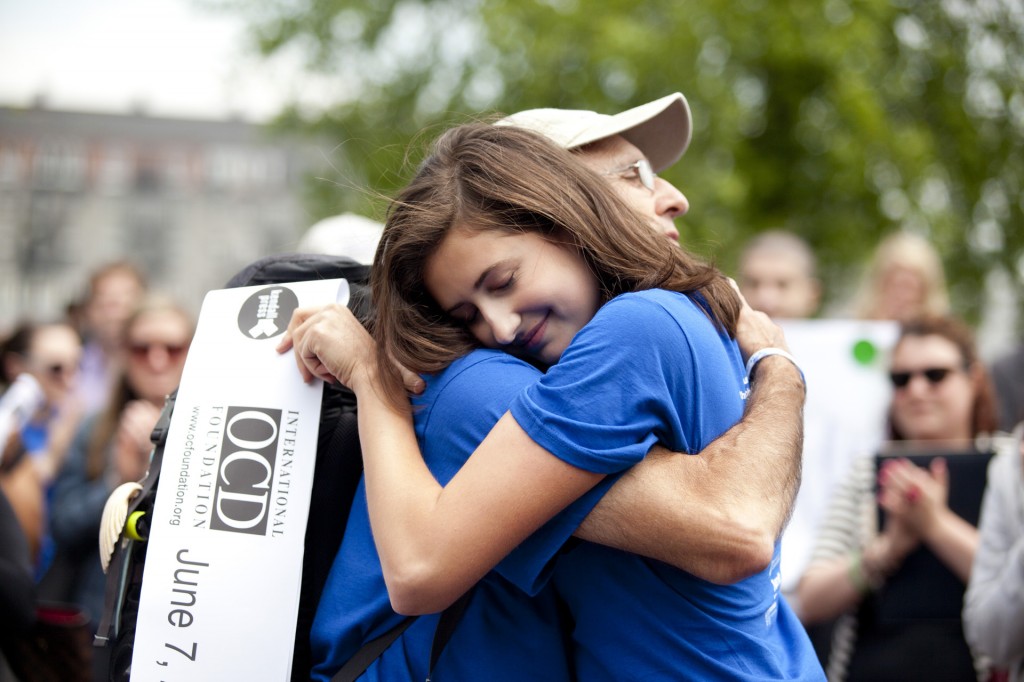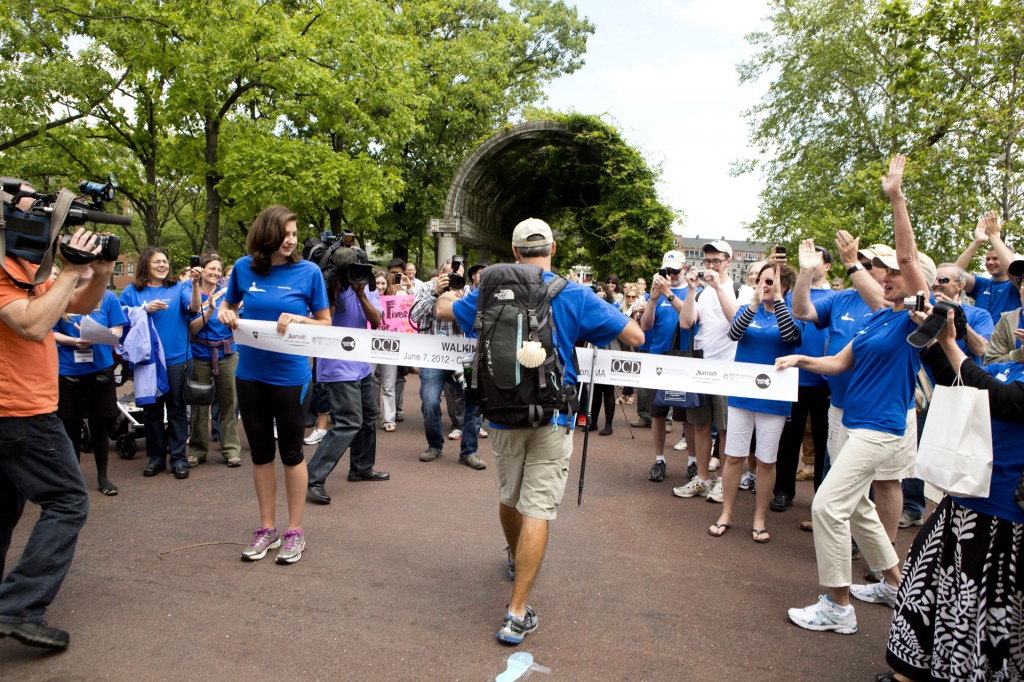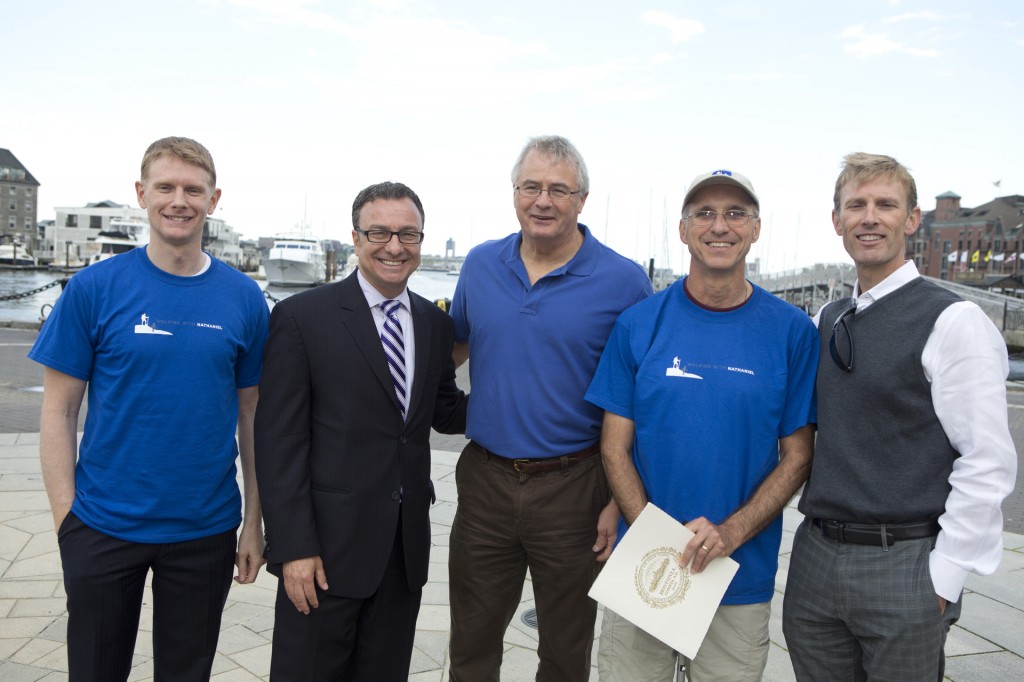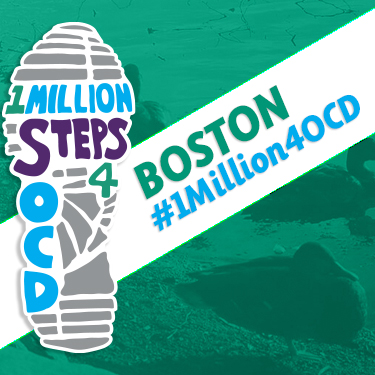 Rally Remarks
Rally Remarks
(Watch the Video footage here)
A big thank you goes to many different people and organizations. I’m somewhat at a loss as to where to start. Let me begin with the founders of the feast of the Camino de Nathaniel Project—the enduring spirit of our son, Nathaniel, my wife, Judy, my daughter, Carrie, and the constant support of Jeff Szymanski and his wonderful staff at the International OCD Foundation. None of you laughed when I first mentioned this project. You were genuinely intrigued, asked for more information, noticed my enthusiasm and energy, and asked how you could help. The 45 days of the Camino de Nathaniel are the fruits of your unconditional love and support.
Today’s thanksgiving include our Rally mc, David Brown, Boston City Councilman, Sal LaMattina, Nancy Farrel of the American Foundation for Suicide Prevention, and Dr. Michael Jenike of the Scientific Advisory Board of IOCDF. Of course, thank you to our generous sponsor—The Mass General Hospital OCD and Related Disorders Clinic, The OCD Institute at McLean Hospital, and Longwharf Marriott Hotel across the green. And then there are all you folks present here today at this rally to cheer me in. You deserve special recognition. I’m also aware of all the walkers, actual and virtual, who kept me steady on the road and reminded me constantly of their loving presence. Whether in deepest PA, in rural Western New Jersey, or in beyond-Great-Neck Long Island, that kind of support was so appreciated. Thank you, hospitals, clinics, treatment centers, and doctor’s offices for opening your doors and for listening attentively to Nathaniel’s story.
The initial goal of the project was for me to “walk” cross the finish line. And I did that! But I confess that 45 days ago, I envisioned a slow crawling-in scenario. Either would have worked. The scary nature of a finish line, however, is this–does it mark the end of a wonderful accomplishment with many stories to tell and growth to show? Or is it about the start of everything that comes next, whatever that may be?
I had to do this walk. The call to me was so crystal clear. However, the innumerable details and scope of the actual execution of the pilgrimage were a bit daunting. Who do I think I am to walk a “pilgrimage” in the 21st Century, to do it on the busy roads of the eastern corridor of the United States, and to initiate conversations about what’s most invisible in our society, brain disorders? Why should I make visible the invisible?
Last year when Nathaniel died, my sister-in-law, Dr. Carol Nicholson, a philosophy teacher in NJ, wrote in a sympathy card the following, “We have much to learn from the undeserved suffering of extraordinary people.” Right on, Carol. Nathaniel was indeed extraordinary, and he simply didn’t deserve to suffer OCD and BDD. No one ever deserves this kind of mental suffering and pain in life. What was the universe thinking when it robbed us of the precious life and talents of such a handsome, intelligent, funny, compassionate, and loving young man? Nathaniel was indeed an “orchid” child—just like the flower that requires special care and nurturing, because we know that by doing so, eventually the bloom will be extraordinary, and we will all be delighted and enriched by the display.
In my left pocket, I have carried for well over a year a laminated photo of my son. For this pilgrimage, I walked with a new copy in color. In Bethlehem, PA, I did my first laundry load. Yeah! Unfortunately, I forgot to remove the photo from the pocket. After being washed and dried, the photo became cracked and creased. I was so disappointed. But then, there are no accidents, are there? BDD is all about being a broken image in the mirror. Nathaniel often said to us at the end, “I’m broken.” I now carry every day his disease in my pocket, and the damaged photo reminds me constantly of why I ‘m doing this journey.
Every step I took on the Camino de Nathaniel, and there were well over 1 million of them, we, Nathaniel and I, did it for you, as well as for ourselves. He was the compassionate taskmaster who repeatedly reminded me to put one foot in front of the other, to watch out for the crazy, mindless, texting, speeding drivers, to avoid the prolific poison ivy growing on the sides of the road, to accept the wetness of the rain from the sky and from the splashes of passing cars, to be brave enough to tell his story to total strangers, to be constantly flexible, resourceful, and resilient despite my age, to get used to sleeping in 42 different beds in seven weeks, to always welcome the limitations (availability of lodging and food), to move deliberately forward through the many deserts of solitude, but most of all to raise awareness about brain disorders, especially OCD/BDD.
So what did I learn after 552 miles, or one million one-hundred ten thousand steps?
- Well, first, I learned that not many people know about BDD. Folks, we’ve got to do something about that ignorance.
- Parents, caregivers, siblings, and friends who live in the arena of the disease desperately need professional support.
- Living in the present is much more rewarding than living in the unchangeable past or the imagined future.
- Google Maps Walking Directions are accurate, for the most part, although its liability clause is clearly stated, “Walking directions are in beta; please use caution.” That’s their legal CYA (Cover Your Asselin)
- There are many good folks out there, total strangers, who listened to Nathaniel’s story, asked good questions, and even cried in empathy when I described Nathaniel’s life and illness.
- There were many acts of generosity of spirit along the path: Janet in Hatfield, PA who handed me a $20.00 bill as her contribution, waitress Lynn in Philippsburg, NJ who paid for my breakfast, several B&Bs on Long Island and in Rhode Island that reduced my lodging fees or offered me a room free of charge, Casey in Mansfield, MA who bought me ice cream in Cold Stone Creamy, and her son, Daniel, who suffers from autism but still managed to shout from the backseat of the car, “Walk safely my new friend.” And what about all the little businesses that let me use the bathroom without my having to buy something in exchange, as if I needed more weight. And of course, I will never forget the many hosts families who offered me hospitality–a comfortable bed, a steaming hot shower, delicious and nutritious meals, and listening ears as I talked about the walk and processed the day’s experience.
Ok…Ok…Ok, fess up, Asselin! It wasn’t always easy out there. For instance, there was the innkeeper in a fancy Bucks Country, PA inn who, when I started to tell Nathaniel’s story, cut me off and said, “I haven’t got time for your story.” Despite her response, I still had enough presence of mind to beg, “Well, can I still use your restroom?”
And then there was Ralph’s King Size Motel in Point Murray, NJ that offered special rates for “Short Stays.” I don’t think they meant naptime for overly tired pilgrims.
And did you know that you can’t use a restroom in some banks, because it’s a security risk? What would I be doing in there that warrants that kind of extra protection?
There were many memorable moments, like the day I had to hug the shoulder of the highway all morning long because of the traffic, and at lunch time, in a lovely small-town restaurant, I realized that an army of ticks were slowly crawling up my legs as I was being served the lunch. That was an interesting challenge.
Nathaniel always walked in front of me—young, healthy, robust, and determined. He definitely was on a mission, and my role was to simply keep up. And the miraculous discovery along the way for me was that if I put one foot in front of the other, I moved forward and eventually got to Boston. With each step I took, I released the pain of the loss of my son, pounded my deep anger into the macadam of the road, appreciated the many deserts of solitude along the way, and mastered the art of kinesthetic mindfulness. This walk was for me a pilgrimage of hope and of new possibilities.
The Camino de Nathaniel’s Finisterre (The End of the Earth) is Boston Harbor here next to this park. Last week, Earlham College’s May Term in Spain finally arrived at the Finisterre on the other side of the Atlantic. I had asked the group to leave behind for me a small stone with the word “Courage” inscribed on it. Today I still carry its mate in my pocket, a stone with the word “Grace.” It will find its way into the waters of Boston Harbor after this event. The circle is now complete. But if indeed it is a circle, then there is actually no finish or start line. My Camino has not ended. Neither has yours. It’s just beginning.
Ancient Pilgrims in Spain who finished the Camino de Santiago used to take off their clothes and burn them on the rocks of Finisterre on the Atlantic Coast. I will spare you the sight of such a scene on my behalf. Theirs were probably quite worn and smelly, mine a little less so thanks to laundromats. But the ritual remains beautiful in the sense that it invites us to shed the old and to begin “anew.” Let’s us all do just that as we recommit to spread awareness about OCD/BDD, to tell Nathaniel’s and our own stories to others, to give generously to the International OCD Foundation, and to always put one foot in front of the other as we walk the huge challenge that lies before us.
Ultreya and Buen Camino!




2 Responses to June 7, 2012 — Part two — The Rally (Total miles: 552)